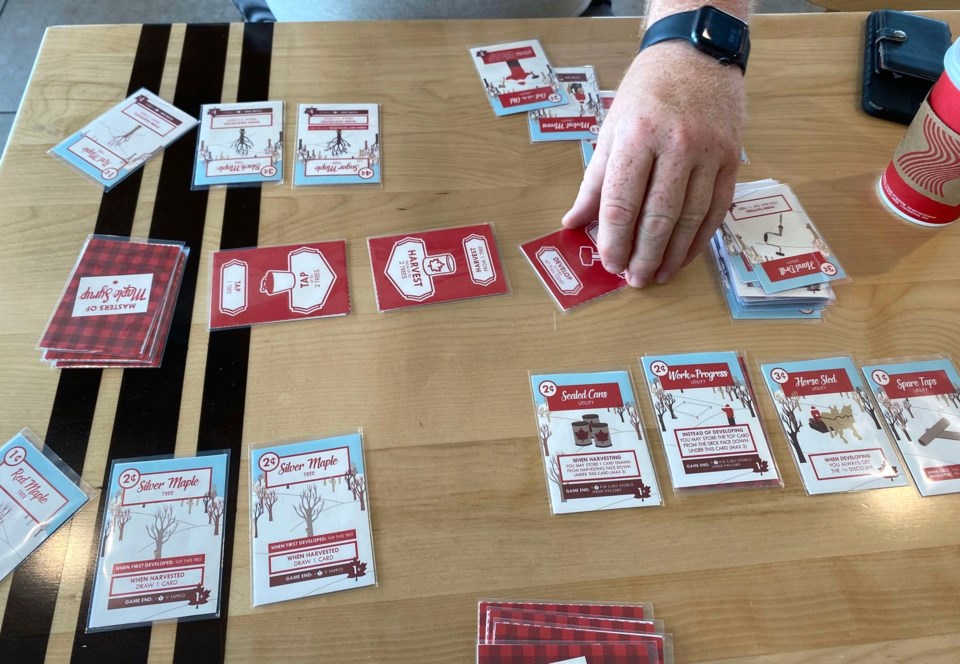YORKTON - With the start of September we roll close to ‘Culture Days’ in Canada so for the next month the main game reviewed will be by a Canadian designer.
This week I just have to go for the chuckle first and suggest Masters of Maple Syrup is a sweet little game.
OK that’s rather corny, but it is actually quite accurate.
In Masters of Maple Syrup, players develop their property tableaus by adding trees to harvest sap from and utilities to improve their syrup production. On their turn, the active player determines the action both players will take, with a slight advantage in their favour.
It’s a very ‘Canadian’ theme, admitted designer Sébastien Bernier-Wong when it came to where the core idea originated.
“A few different factors came together to inspire Masters of Maple Syrup. Growing up with one foot in a French Canadian community, always having a can or jug of maple syrup on hand in my childhood home and visiting a friend's parent's sugarbush to name a few,” he said.
The opportunity knocked as they say.
“It was 2018 and I had a lot of free time on my hands in between guiding seasons and had been working on a heavier game called Sloops -- later published as Seas of Havoc -- but wanted a smaller, more personal project that both my partner and I could enjoy together. The maple syrup theme came first, it was broadly relatable, quaint and I hadn't seen a game about it yet.
“The game's gone through multiple iterations since then, from being an 18 card game hand delivered to friends and family to a small run 36 card game (there's 300 of them out there somewhere) to it's final version now as a 54 card game.”
The game ends at the end of a round where any player has placed 10 cards on their property (tableau). Scores are tallied from the value of cards on each players’ properties and any additional scoring bonuses the cards offer. The player with the highest value on their property wins.
On a turn you choose an action, but at the same time as you take it, your opponent also takes the same action, albeit a slightly less powerful one. For example, you might choose develop, allowing you to play a card to your ‘farm’ at a reduced cost. Your opponent can play a card too, but at full cost.
It’s a neat little mechanic you will see elsewhere, but it works nicely here.
The ‘shared’ actions ultimately mean game scores are going to be close, and being the first one to play 10 cards is not an assurance of a win either.
In that respect designer Sébastien Bernier-Wong has done a great job.
“I wanted it to be a cozy cabin game,” he said. “Competitive, but not combative. Some of the language in the game was chosen with that goal in mind specifically. ‘Opponent’ is replaced with ‘neighbour’ for example, implying you're friendly, but that there may be some one-upmanship involved.”
The cozy competitiveness is in itself a game draw.
So I asked the designer, in your mind what is the best element of the game and why?
“I like that the game can lure new and casual gamers in with its theme and then introduce them to hobby game mechanisms,” said Bernier-Wong. “It's a light game, all things considered, but it plays differently each time and challenges you to try new cards out. I like that it invites newer players to talk hobby game strategy with veteran board gamers. . .
“You can count on the game being pleasant. You're always doing something positive towards developing your property, even on your neighbour's turn. There's hardly any downtime and the decision space is large enough to keep you thinking, but not so huge as to paralyze new players. Its a quick, enjoyable little game to pass the time with a loved one.”
Bernier-Wong is also the artist here and the art is fantastic (OK Trevor was less enamoured than I), but it reminds me of 1950’s Christmas cards, and it works.
The card backs – we have a Print n Play copy and I printed the backs which I do not always do – are sweet too in a very Canadian-esque black and red plaid design. I must ask my better half to watch for a red & black lumberjack shirt for me this fall, but I digress.
Overall this ‘little’ game hit a ‘sweet’ spot for two – yes I went back to the chuckle -- and is highly recommended.
You can find this solid two-player card game at






